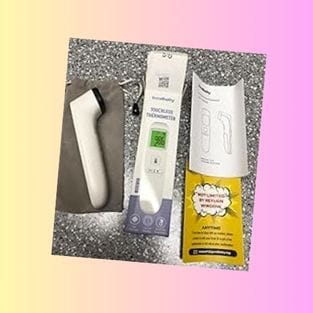Key Takeaways:
- Understand the benefits and functionality of non-contact infrared thermometers for both kids and adults.
- Learn how to accurately use a digital infrared thermometer for reliable results.
- Discover the top features to look for when selecting a non-contact thermometer for home use.
In the age of technology and health consciousness, monitoring your family's health has never been more accessible.
Non-contact infrared thermometers have emerged as a staple in households, providing a quick, accurate, and hygienic way to check body temperatures.
This post will walk you through the ins and outs of digital infrared thermometers, ensuring you're well-equipped to make an informed decision for your home health care needs.
What are Non-Contact Infrared Thermometers?
Non-contact Infrared Thermometers (NCITs) are innovative medical tools designed for rapid and non-invasive temperature measurement, offering a less distressing experience for children compared to traditional methods.
Similar to infrared tympanic thermometers, NCITs are capable of delivering quick temperature readings, typically within a matter of seconds.
*It's important to note that these thermometers are engineered to measure the temperature of the skin or surface, rather than the body's internal temperature.
The Rise of Non-Contact Thermometers
The recent global health events have underscored the importance of having reliable health monitoring tools at home.
Non-contact thermometers, using infrared technology, allow for temperature readings without physical contact, minimizing the risk of cross-contamination and the spread of germs.

*This feature is particularly beneficial in households with young children or multiple family members.
How Do Non-Contact Thermometers Work?
Non-contact infrared thermometers measure the infrared energy emitted by the body to determine temperature.
They allow temperature to be measured without contacting the object (or your body) at all. When triggered, light bounces off the surface of the object and detects radiation emitted from the object. The thermometer then infers the temperature based on that electrical emission with impressive accuracy.
This energy is collected through the device's lens and converted into a temperature reading displayed on the screen.
*The process is quick, often taking just a few seconds, making it ideal for fussy children or adults who require frequent monitoring.
Accuracy and Reliability
When it comes to health, accuracy is paramount.
High-quality non-contact thermometers are designed to provide precise readings.
*To ensure reliability, it's crucial to follow the manufacturer's instructions for use, such as aiming the thermometer at the correct area (typically the forehead) and maintaining the recommended distance from the skin.
Ease of Use and Convenience
One of the biggest advantages of digital infrared thermometers is their ease of use --- With simple button operations and clear digital displays, they can be used by anyone in the family.
*Additionally, the non-contact feature allows for temperature readings while a child is asleep, causing no disturbance.
Features to Consider
When shopping for a non-contact thermometer, consider features such as
- memory recall, which stores previous temperature readings,
- a fever alert system, and an easy-to-read backlit display.
Some models also offer color-coded readings to quickly identify normal, elevated, or high temperatures.
Safety and Hygiene
Non-contact thermometers offer a hygienic alternative to traditional thermometers that require physical contact and can harbor bacteria or viruses.
By eliminating the need to touch the skin or clean the device between uses, these thermometers provide a safer option for families.
Versatility for All Ages
Digital infrared thermometers are versatile tools suitable for individuals of all ages, from infants to the elderly.
*Their non-invasive nature makes them less intimidating for children and more comfortable for adults, ensuring a stress-free experience for everyone involved.
Calibration and Maintenance
To maintain the accuracy of your non-contact thermometer, it's important to understand the calibration process — Some models self-calibrate, while others may require manual calibration.
Regular maintenance, such as replacing batteries and cleaning the lens, also contributes to the device's longevity and performance.
Choosing the Right Brand
With numerous brands on the market, selecting the right non-contact thermometer can be overwhelming.
Look for brands with positive reviews, reliable customer service, and warranties.
*It's worth investing in a trusted brand to ensure the health and safety of your family.
Practical Examples and Case Studies
Consider the case of a family with young children, where
- a non-contact thermometer provided peace of mind during flu season by allowing for quick temperature checks without waking the children.
Another example is
- a caregiver for an elderly relative who found a non-contact thermometer essential for regular monitoring without causing discomfort.
FAQ Section
Q: How accurate are non-contact thermometers?
A: Non-contact thermometers are highly accurate when used according to the manufacturer's instructions. It's important to aim the thermometer properly and use it in the recommended environmental conditions to ensure precise readings.
Q: Can I use a non-contact thermometer for both children and adults?
A: Yes, non-contact thermometers are designed to be versatile and can be used for individuals of all ages, making them perfect for family use.
Q: How do I clean and maintain my non-contact thermometer?
A: To clean your non-contact thermometer, gently wipe the lens and body with a soft, dry cloth. Avoid using abrasive cleaners or submerging the device in water. For maintenance, replace batteries as needed and refer to the user manual for calibration instructions if required.
Your Takeaway
Non-contact thermometers for kids and adults are invaluable tools for home health monitoring.
They offer a combination of accuracy, convenience, safety, and hygiene that traditional thermometers cannot match.
By understanding how they work, what features to look for, and how to maintain them, you can ensure your family's health is monitored effectively and efficiently.
Disclaimer.
When you purchase through links on our site, we may earn an affiliate commission (that's how we stay in business). FirstFewFinds may use affiliate links to products and services on retailer sites for which we can receive compensation if you click on those links or make purchases through them. We hope you find the list of our first few finds useful and helpful. Each product on our list has been carefully chosen by our writers and all opinions are our own. Check your choices and enjoy finding exactly what you need!








